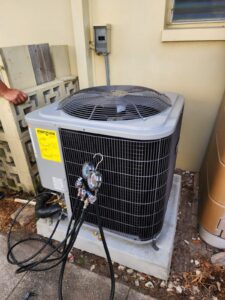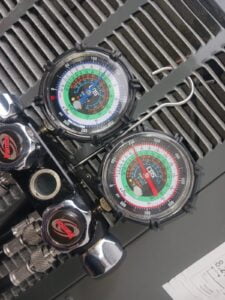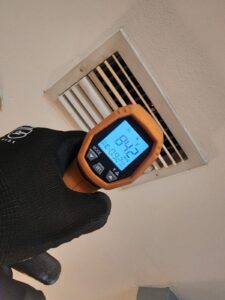AC Facts or Fiction?
Air conditioning is a modern marvel that has transformed our lives, offering comfort in the sweltering heat and making indoor living more pleasant. However, there’s more to air conditioning than just cooling. In this blog, we’ll dive into seven astonishing facts about air conditioning that go beyond its basic function. These facts will not only surprise you but also provide a deeper appreciation for this incredible invention. So, let’s chill and explore the hidden truths and myths about air conditioning.

Fact 1: The Origins of Air Conditioning
Air conditioning, as we know it today, has a history that dates back to ancient times. The concept of cooling air for comfort can be traced to ancient Egypt, where reeds hung in windows were moistened with trickling water. The evaporation of water cooled the air blowing through the window, creating an early form of air conditioning. Fast forward to the 2nd century China, where an inventor named Ding Huan created a manually operated rotary fan that could cool an entire hall of people.
However, the birth of modern air conditioning is credited to Willis Haviland Carrier. In 1902, Carrier invented the first modern air conditioner in Brooklyn, New York. Initially designed to control humidity in a printing plant, his invention also had a significant impact on temperature control. Carrier’s invention laid the foundation for the modern air conditioning systems we use today.
Fact 2: Air Conditioning and Summer Blockbusters
Did you know that air conditioning played a pivotal role in the birth of the summer blockbuster? In the early 20th century, movie theaters were among the first public places to have air conditioning. This made theaters a cool escape from the summer heat, leading to the tradition of releasing big-budget films during the summer. The term “summer blockbuster” was born from this trend, with theaters becoming a haven for people seeking entertainment and relief from the scorching temperatures outside.
One of the first films to benefit from this trend was “Gone with the Wind,” released in 1939. However, it was the 1975 film “Jaws” that cemented the concept of the summer blockbuster. The success of “Jaws,” partly attributed to audiences flocking to air-conditioned theaters, changed how movies were released and marketed, making summer the season for the biggest and most exciting movie releases.
Fact 3: Air Conditioning’s Impact on Architecture
The advent of air conditioning significantly influenced architectural design. Prior to air conditioning, buildings were designed with high ceilings, large windows, and porches to facilitate airflow and reduce heat. However, with the widespread adoption of air conditioning, architects no longer needed to incorporate these natural cooling elements.
This shift led to the modern skyscraper’s development, as air conditioning made it possible to build taller buildings with more usable space. The design of homes also changed, with features like smaller windows, lower ceilings, and a lack of porches becoming more common. Air conditioning has thus played a crucial role in shaping the urban landscapes we see today.
Fact 4: The White House and Air Conditioning
The White House, the official residence of the President of the United States, was one of the first buildings to be equipped with air conditioning. In 1929, Herbert Hoover had an air conditioning system installed in the Oval Office to beat the Washington D.C. heat. This installation marked a significant moment in the history of air conditioning, as it was one of the earliest examples of its use in a government building.
The system was a luxury at the time and a symbol of technological advancement. Over the years, air conditioning in the White House has been upgraded and modernized, ensuring that the occupants can conduct the nation’s business in comfort, regardless of the outside temperature.
Fact 5: Air Conditioning and Human Productivity
Air conditioning has had a profound impact on human productivity. Studies have shown that comfortable temperatures can significantly improve concentration and efficiency. Before air conditioning, industries and offices would often slow down or even shut down during the hottest months. The introduction of air conditioning enabled businesses to operate year-round without interruption, boosting productivity.
In educational settings, air conditioning has also been shown to improve learning conditions. Students are more alert and focused in comfortable environments, leading to better academic performance. This effect extends to various sectors, from manufacturing to technology, highlighting air conditioning’s role in enhancing workplace productivity and efficiency.
Fact 6: Air Conditioning and Health
Air conditioning has contributed significantly to public health. By controlling temperature and humidity, air conditioning helps reduce the spread of certain diseases, particularly those exacerbated by heat and moisture. It also provides relief for individuals with respiratory issues, as it can filter and purify the air, removing allergens and pollutants.
However, it’s essential to maintain air conditioning systems properly. Poorly maintained systems can become breeding grounds for mold and bacteria, potentially causing health issues. Regular maintenance and cleaning of air conditioning units are crucial for ensuring they provide health benefits without any adverse effects.
Fact 7: The Future of Air Conditioning
As we look to the future, air conditioning is set to evolve with advancements in technology and growing environmental concerns. Innovations in energy efficiency, such as solar-powered and geothermal systems, are becoming more prevalent. These systems offer sustainable cooling solutions, reducing the environmental impact of traditional air conditioning.
Additionally, smart technology is being integrated into air conditioning systems, allowing for more precise control and energy savings. Features like AI-driven temperature adjustments and remote smartphone control are becoming standard, providing users with unprecedented convenience and efficiency.
The future of air conditioning is not just about cooling; it’s about doing so in a way that is sustainable, efficient, and in harmony with our environment.
Fact 8: Air Conditioning and Computer Technology
The critical role of air conditioning in the development of computer technology is a fascinating fact. Early computers were large machines that generated significant heat, requiring air conditioning to maintain operational temperatures. The fact that air conditioning was essential for the advancement of computing technology underscores its importance in the evolution of modern technology.
Fact 9: The Largest Air-Conditioned Space
NASA’s Vehicle Assembly Building, one of the largest air-conditioned spaces in the world, is a remarkable fact that illustrates the scale at which air conditioning can be applied. This massive building, used for assembling space vehicles, demonstrates the technology’s capability to manage climate control in large and complex environments.
Fact 10: Air Conditioning and Energy Consumption
The significant energy consumption attributed to air conditioning is an important environmental fact. In the United States, air conditioning accounts for a substantial portion of electricity use, especially during peak summer months. This fact highlights the ongoing need for more energy-efficient cooling solutions and the importance of sustainable practices in air conditioning usage.
Fact 11: The Term “Air Conditioning”
The coining of the term “air conditioning” by Stuart W. Cramer in 1906 is an interesting linguistic fact. Cramer used the term in a patent claim for a device that added moisture to the air in his textile plants. This fact not only marks the origin of the term but also shows the early connection between air conditioning and industrial applications.
Fact 12: Air Conditioning in Space Missions
The necessity of air conditioning in space missions is a fact that underscores its critical role in maintaining habitable environments in space. Spacecraft and space stations require sophisticated air conditioning systems to regulate temperature and ensure air quality. This fact highlights the technology’s versatility and its ability to adapt to the most challenging environments.
Fact 13: The Impact on Movie Theaters
As mentioned earlier, air conditioning helped popularize movie theaters, especially during the summer months. However, it also changed the design of theaters. Before air conditioning, movie theaters were built with a gap at the top of the walls for ventilation. With the advent of air conditioning, theaters could be fully enclosed, which improved sound quality and allowed for more immersive movie experiences.

What is a fun fact about cooling?
One intriguing fun fact about cooling is that the invention of modern air conditioning was driven by the need to solve a problem in the printing industry, rather than for human comfort. In 1902, Willis Haviland Carrier, an engineer, developed the first modern air conditioning system. This invention was not initially intended to cool people but to control humidity and temperature in the Sackett-Wilhelms Lithographing and Publishing Company in Brooklyn, New York.
Carrier’s invention was designed to tackle a significant challenge in the printing process. At that time, printers struggled with the varying levels of humidity which affected the alignment of ink and paper. During humid conditions, the paper would expand, and the ink would not align correctly, leading to poor-quality prints. Carrier’s system was able to stabilize the humidity by cooling the air and removing excess moisture. This not only improved the printing process but also had a profound impact on the quality and efficiency of printing.
The success of Carrier’s invention in the printing industry led to the realization that this technology could be used for comfort cooling in other settings. The concept of using air conditioning for human comfort started to gain popularity, and soon, air conditioning systems were being installed in theaters, stores, and eventually in homes.
Carrier’s invention marked the birth of the modern air conditioning industry. It revolutionized not just the printing industry but also transformed how people lived and worked, especially in regions with hot and humid climates. The ability to control indoor climates led to significant changes in architectural designs, increased productivity in various industries, and improved overall quality of life.
This fun fact about the origins of cooling highlights how a solution to a specific industrial problem can lead to a groundbreaking invention with widespread applications, changing the course of modern living and comfort.

The Fun and Fictional Misconceptions About Air Conditioning
Myth 1: Turning the Thermostat Way Down Cools Your Home Faster
One of the most common myths about air conditioning is that setting the thermostat to a much lower temperature than desired will cool the home faster. This misconception stems from the belief that air conditioners work harder when set to lower temperatures. However, the truth is that most AC units work at a consistent rate, regardless of the temperature setting. Setting the thermostat significantly lower only makes the unit run longer, not faster, leading to increased energy consumption and higher bills. The key to efficient cooling is to set the thermostat at a comfortable, steady temperature.
Myth 2: Air Conditioning Units Only Cool the Air
Many people believe that air conditioning units are solely for cooling the air. While cooling is their primary function, modern air conditioners also play a significant role in reducing indoor humidity. By removing moisture from the air, AC units create a more comfortable and less humid environment. This dual function is particularly important in areas with high humidity levels, where excess moisture can make the air feel warmer than it actually is.
Myth 3: You Don’t Need Regular Maintenance if the AC is Running Fine
A prevalent myth is that air conditioning units don’t require regular maintenance if they appear to be running smoothly. Neglecting routine maintenance can lead to decreased efficiency and potential breakdowns. Regular maintenance, such as cleaning or replacing air filters and inspecting cooling coils, is crucial for ensuring your AC unit operates at peak efficiency and has a longer lifespan. It’s always better to prevent issues than to deal with costly repairs.
Myth 4: Ceiling Fans Lower Room Temperatures
Many people think that running a ceiling fan in a room will lower the temperature. In reality, ceiling fans do not reduce room temperature; instead, they circulate air, which creates a wind-chill effect that makes the room feel cooler to the occupants. This misconception often leads to leaving fans on in unoccupied rooms, which is unnecessary and wastes energy. The best practice is to use ceiling fans in conjunction with air conditioning for increased comfort and to potentially raise the thermostat setting a few degrees to save energy.
Myth 5: Bigger AC Units Provide Better Cooling
The myth that bigger air conditioning units provide better cooling is a common misconception. The size of an AC unit should be appropriately matched to the space it needs to cool. An oversized unit can lead to short cycling, where the AC turns on and off frequently, failing to dehumidify the air properly and leading to uneven temperatures and increased wear on the system. Conversely, an undersized unit will struggle to cool the space adequately. Proper sizing is key to efficient and effective cooling.
Myth 6: Closing Vents in Unused Rooms Saves Energy
Many believe that closing vents in unused rooms will save energy and reduce cooling costs. However, this is a myth. Modern HVAC systems are designed for a balanced airflow throughout the home. Closing vents can disrupt this balance, causing the system to work harder and potentially leading to increased energy usage and even damage. It’s better to keep vents open and ensure a consistent airflow for optimal system performance.
Myth 7: Air Conditioners Produce Fresh Air
A common misconception is that air conditioners produce fresh air. In reality, AC units recirculate indoor air. While they can filter and cool the air, they do not replace it with air from outside. This myth underscores the importance of regular ventilation and air filter maintenance to ensure good indoor air quality. Opening windows when the weather permits or using exhaust fans can help introduce fresh air into your home.
Myth 8: Lowering the Thermostat at Night Doesn’t Save Energy
Some people believe that lowering the thermostat at night does not save energy. However, this is a myth. Reducing the thermostat setting during the night or when the house is unoccupied can lead to significant energy savings. Programmable thermostats are an excellent tool for automatically adjusting temperatures based on your schedule, ensuring comfort while optimizing energy use.
Myth 9: Air Conditioning is Only for Hot Climates
The myth that air conditioning is only necessary in hot climates overlooks its importance in managing indoor humidity and providing comfort in various climates. In areas with moderate temperatures but high humidity, air conditioning can significantly enhance indoor comfort by removing excess moisture from the air. This myth also ignores the fact that many modern air conditioning systems are combined with heating functions, making them useful year-round in a variety of climates.
Myth 10: Freon Needs to be Replenished Regularly
A common myth is that the refrigerant in air conditioners, commonly referred to as Freon, needs to be replenished or “topped off” regularly. In reality, Freon is not a fuel but a coolant that circulates within a closed system. If your AC is low on Freon, it indicates a leak in the system. Properly functioning air conditioners should not lose Freon, and any loss of refrigerant requires professional attention to repair the leak and recharge the system.
AC Facts or Fiction? Unraveling the Truths with The AC Therapist
In our journey through the intriguing world of air conditioning, we’ve uncovered the truths behind common myths and misconceptions. Understanding the realities of how AC systems work not only enhances our appreciation for this essential technology but also guides us in making informed decisions about its use and maintenance. At The AC Therapist, we’re committed to providing not just top-notch air conditioning services, but also reliable information to help demystify the complexities of HVAC systems.
Remember, whether it’s about the efficiency of your AC unit, the importance of regular maintenance, or the best practices for optimal cooling, the facts always matter. By separating fact from fiction, we empower ourselves to create more comfortable, energy-efficient, and healthy living environments. If you ever find yourself puzzled by an air conditioning myth or in need of professional advice, The AC Therapist is here to offer expert guidance and quality service. Let’s keep our cool by staying informed and trusting the experts in air conditioning care.









